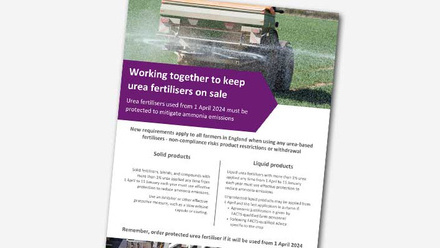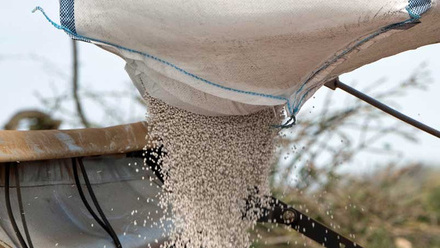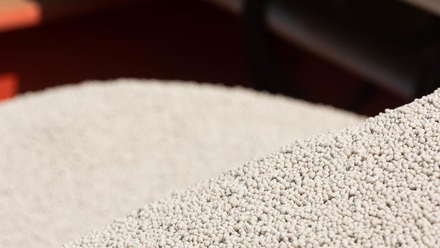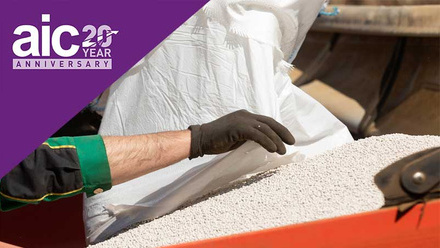Urea "Option 4" Ammonia Mitigation
The agricultural supply industry and farming unions partnership is committed to delivering substantial ammonia emissions reductions from the use of both solid and liquid fertilisers containing urea from April 2023 in lieu of regulation.
Fertiliser containing urea must only be applied where the following requirements are met:
- Protected/inhibited fertilisers containing solid urea can be applied within any product use-by/best-before dates.
- Protected/inhibited fertilisers containing liquid urea can be applied with the prescribed rate of protector/inhibitor for the application, and within any product use by/best before dates.
- In England, unprotected/uninhibited solid fertiliser containing urea can only be applied between 15 January and 31 March.
- In England, unprotected/uninhibited liquid fertiliser containing urea can be applied between 15 January and 31 March.
- In England, unprotected/uninhibited liquid fertiliser containing urea can be applied between 1 April and the last application in autumn only if agronomic justification is provided by FACTS-qualified farm personnel or advice specific for the crop has been provided by a FACTS-qualified adviser and been followed (see EC 9.1).
In Northern Ireland, Scotland and Wales fertiliser containing urea (solid and liquid) can be applied as per relevant legislation.
Uptake will be monitored through fertiliser sales and treatment data, Red Tractor monitoring data, and the British Survey of Fertiliser Practice. This will establish whether the ammonia abatement expected is achieved.
In addition, Defra will gather relevant data to monitor and assess the level of ammonia abatement achieved by the scheme.
All applications should be made before the end of October in accordance with RB209.
Under the industry-led scheme, the consortium and fertiliser suppliers will:
- adapt to anticipated change in demand for protected/inhibited fertilisers and AN-containing fertiliser, after 1 April 2023
- advise farmers, through their FACTS Qualified Advisers, of the best ammonia mitigation strategy (product choice, rate, timing) level of improvement considering the need for continuous improvement in nitrogen use efficiency to enhance crop performance and reduce overall nitrogen losses to reducing nitrous oxide to air and nitrate to water
- require fertiliser suppliers selling fertilisers without advice, to signpost farmers (via invoices, QR codes etc) to further generic guidance on ammonia reduction and FACTS Training module
- require all fertiliser suppliers to clearly state on invoices the inclusion of inhibitor (as relevant for all materials in scope). Hearing this from the voice of Defra would ensure consistency across the board (making sure everyone involved knows that there is a requirement for the audit trail)
- provide supporting guidance to Red Tractor auditors on the new standards, what information the farmer needs to provide to demonstrate compliance with the new standards, and provide farmers with clarity on how to comply.
- all mineral fertilisers, for agricultural use, containing 1% ureic nitrogen or more are in scope with the exception of urea solution for late-season foliar application
- assess and register any non-conformance from October 2023 and report back with early interim results to all Industry Partners and Defra by July 2024 and full results by the end of 2024 and each subsequent year. Detailed guidance on conformance will be issued along with the publication of the standard in April 2023
- issue a sanction for non-conformance – where farmers are to take a FACTS Training module (and on-line assessment) covering best practice for managing ammonia loss from fertilisers containing urea as well as from organic fertilisers
- develop training for reducing ammonia losses from mineral and organic fertiliser applications (including guidance on mitigation on days before April 1st based on soil temperature etc and considering the opportunities for financial savings).
- develop (with the Health & Safety Executive) and disseminate a manual for the safe handling of urease-inhibited/protected products and materials sold for on-farm inclusion
- run a communications campaign to disseminate the new Red Tractor standards and requirements in England, including a campaign on nitrogen use efficiency
The roll-out will be tracked from October 2024 with an expectation of significant ammonia emissions abatement by the end of 2024.
This would inform the government of the potential part this approach will play in meeting its national air quality obligations and therefore assess the need for any regulatory intervention.
The industry consortium will not be limiting their ambition to 11.2kt aiming to close the gap between 11.2Kt and 14.1kt (Defra’s alternative regulatory Option 2a mandating the use of UIs/protected fertilisers containing urea, all year round).
This will be done with the support of the wider ambitions of the consortium’s nutrient management campaign to 2030.
The concept of improving nitrogen use efficiency by improving farm nutrient balance is well embedded in Option 4 and co-benefits for ammonia mitigation are expected as a result.
For additional information, visit the NFU website and BASIS website.








